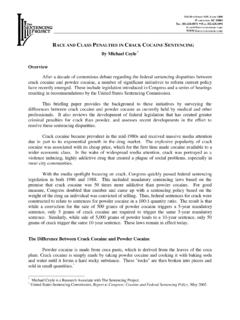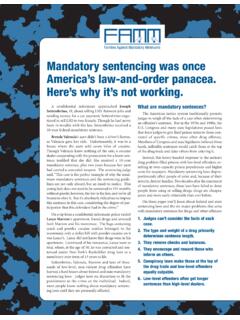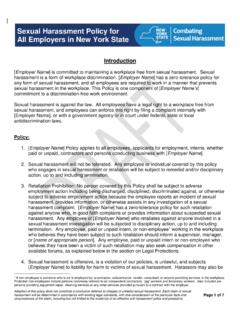Transcription of Women in Prison: A Fact Sheet - Prison Policy Initiative
1 Women in Prison : A Fact Sheet The Issue: sexual Assault and Misconduct Against Women in Prison The imbalance of power between inmates and guards involves the use of direct physical force and indirect force based on the prisoners total dependency on officers for basic necessities and the guards ability to withhold privileges. Some Women are coerced into sex for favors such as extra food or personal hygiene products, or to avoid punishment. Powerlessness and Humiliation There are 148,200 Women in state and federal prisons.
2 In federal Women s correctional facilities, 70% of guards are male. Records show correctional officials have subjected female inmates to rape, other sexual assault, sexual extortion, and groping during body searches. Male correctional officials watch Women undressing, in the shower or the toilet. Male correctional officials retaliate, often brutally, against female inmates who complain about sexual assault and harassment. Retaliation and Fear In many states guards have access to and are encouraged to review the inmates personal history files (this includes any record of complaints against themselves or other Prison authorities).
3 Guards threaten the prisoner s children and visitation rights as a means of silencing the Women . Guards issue rules-infraction tickets, which extend the woman s stay in Prison if she speaks out. Prisoners who complain are frequently placed in administration segregation. Impunity Ineffective formal procedures, legislation and reporting capacity within jails and prisons accounts for much of the ongoing sexual abuse of Women . In 1997, according to the US Justice Department only 10 Prison employees in the entire federal system were disciplined, and only 7 were prosecuted.
4 If a Prison official is found guilty, he is often simply transferred ( walked off the yard ) to another facility instead of being fired. The inmate may also be transferred. See also Amnesty International USA s The Issue:: sexual Assault and Misconduct Against Women in Prison The Issue: Sentencing and The War on Drugs A 1997 study by the Department of Justice found that Women were over represented among low level drug offenders who were non-violent, had minimal or no prior criminal history, and were not principal figures in criminal organizations or activities, but nevertheless received sentences similar to high level drug offenders under the mandatory sentencing policies.
5 From 1986 to 1996 the number of Women sentenced to state Prison for drug crimes increased ten-fold. According to The Boston Globe, "nearly 26% of the nearly 2000 men and Women crowding Massachusetts prisons for drug crimes are first-time Worse, nearly three out of four drug traffickers who do get charged in major cases, but agree to forfeit substantial drug money to prosecutors, bargain their way out of the long The result: those with no money or information to trade face the hard mandatory sentences." From 1986 to 1996, the number of Women sentenced to state Prison for drug crimes increased from 2,370 to 23,700.
6 (Bureau of Justice Statistics, Washington DC Prisoners in 1997) In 1986, of Women in Prison were drug offenders. In 1991, of Women in Prison were incarcerated for drug offenses. ( Women in Prison , Survey of State Prison Inmates, 1991. US Department of Justice, March 1994, NCJ 145321) See also Amnesty International USA s The Issue: The War on Drugs: The Source of the Explosion The Issue: Medical Neglect of Women in US Prisons Women are often denied essential medical resources and treatments, especially during times of pregnancy and/or chronic and degenerative diseases.
7 Failure to refer seriously ill inmates for treatment and delays in treatment Women inmates suffering from treatable diseases such as asthma, diabetes, sickle cell anemia, cancer, late-term miscarriages, and seizures have little or no access to medical attention, sometimes resulting in death or permanent injury. Instances of failure to deliver life-saving drugs for inmates with HIV/AIDS has also been noted. Lack of qualified personnel and resources and use of non-medical staff There is too few staff to meet physical and mental health needs.
8 This often results in long delays in obtaining medical attention; disrupted and poor quality treatment causing physical deterioration of prisoners with chronic and degenerative diseases, like cancer; overmedication of prisoners with psychotropic drugs; and lack of mental health treatment. The use of non-medical staff to screen requests for treatment is also common. Charges for medical attention In violation of international standards, many prisons/jails charge inmates for medical attention, on the grounds that charging for health care services deters prisoners from seeking medical attention for minor matters or because they want to avoid work.
9 In some supermaximum prisons, where prisoners cannot work at all, the US Justice Department has expressed concern that charging prisoners impedes their access to health care. Inadequate Reproductive Health Care In 1994, the National Institute of Corrections stated that provision of gynecological services for Women in Prison is inadequate. Only half of the state Prison systems surveyed offer female-specific services such as mammograms and Pap smears, and often entail a long wait to be seen. Shackling During Pregnancy Shackling of all prisoners, including pregnant prisoners, is Policy in federal prisons and the US Marshall Service and exists in almost all state prisons.
10 Shackling during labor may cause complications during delivery such as hemorrhage or decreased fetal heart rate. If a caesarian section is needed, a delay of even 5 minutes may result in permanent brain damage to the baby. Lack of treatment for substance abuse The gap between services available and treatment needs continues to grow. The number of prisoners with histories of drug abuse is growing, but the proportion of prisoners receiving treatment declined from 40% in 1991 to 18% in 1997. Lack of Adequate or Appropriate Mental Health Services 48-88% of Women inmates experienced sexual or physical abuse before coming to Prison , and suffer post-traumatic stress disorder.








